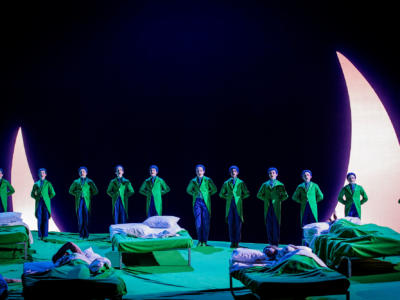An Introduction to The Turn of the Screw
Benjamin Britten composed The Turn of the Screw, his third chamber opera (following The Rape of Lucretia (1946) and Albert Herring (1947)), in response to a commission from the Venice Biennale.
However, delays caused by the writing of Gloriana meant that the new chamber opera was postponed and, in the end, not presented at the Biennale but at the Festival of Contemporary Music. The English Opera Group, conducted by the composer, gave the first performance at La Fenice on 14 September 1954 and introduced it to London three weeks later on 6 October.
Based on a short story by Henry James
Britten had known Henry James’s short story The Turn of the Screw on which the opera is closely based since his teens. Britten recorded in his diary entry for 1 June 1932 (when he was 18) listening to a BBC radio broadcast of ‘a wonderful, impressive but terribly eerie and scary play “The Turn of the Screw” by Henry James’, and in January the following year he read James’s ‘glorious and eerie’ novella, which he considered ‘an incredible masterpiece’.
He was therefore familiar with James’s novella when Myfanwy Piper, wife of the artist and stage designer John Piper, who had been a friend and collaborator of Britten since the mid-1930s, suggested The Turn of the Screw as suitable for operatic treatment.
It only required a small cast: four adult singers and two children, a boy and a girl. Myfanwy Piper
was invited to write the libretto, the first of three she would create for the composer. Screw was to be followed by Owen Wingrave in 1970, also based on a James short story, and Death in Venice in 1973, after Thomas Mann’s celebrated novella.
Take a look at production images from ENO’s 2024 production directed by Isabella Bywater
Photo Gallery
Britten allows the audience to interpret the story
Ambiguity lies at the heart of The Turn of the Screw – indeed, as it does in most of Britten’s operas. For example, what exactly occurred between the valet Peter Quint and children’s former governess Miss Jessel? – both have died before the opera begins, so who, therefore, are the figures we see and hear in the opera? Their ghosts, or figments of the new Governess’s somewhat hyper-active imagination?
James never states what happens between the haunters and the haunted, though when the housekeeper Mrs Grose describes Quint as being ‘free with everyone, with little Master Miles’, there is a distinct implication of something sexual or erotic in the relationship. The themes of corruption and innocence were always powerfully attractive to Britten and The Turn of the Screw is but one example of this strand of his art. Britten and Piper were careful not to interpret the story in any Freudian sense, but rather to shift it to another medium and leave it to subsequent generations of directors, conductors and singers to explore and interpret it as they see fit.
Britten matches the controlled precision of James’s short story with an equally concise, carefully worked out musical structure in which is embedded one of the composer’s favourite instrumental techniques – theme and variations – into the opera’s dramatic arch, with the variations being used to punctuate the rapid almost cinematic sequence of different scenes.
A masterpiece shown in two acts
The opera unfolds over two acts, each of 8 scenes apiece. The Prologue (a later addition) relates through a narrator how a young Governess is engaged for two orphans (Miles and Flora) by their Guardian. Reluctant at first, she eventually succumbs to his persuasion. ‘“I will,” she said’, at which point the orchestra states the Theme.
In Britten’s own words, with this first statement of the Theme, ‘the orchestra, which is the story, starts.’ The Theme employs all twelve notes of the chromatic scale (i.e. the black and white notes on the piano) in a consistent rhythmic pattern. Despite using all twelve notes, Britten’s Theme is clearly tonal and does not emulate the twelve-note style (known as ‘serial music’) of composers from earlier in the twentieth century such as Arnold Schoenberg. The Theme is not attached to any one character in the drama but represents rather the inexorable fate to which all the dramatis personae are subject; inevitably, their musical characterisations are all fertilised by the Theme itself.
The first six notes of the Theme, if re-ordered in stepwise ascent, correspond to the first six notes of the A major scale; the last six, if similarly rearranged, indicate A flat. These are the two polar keys of the opera, A major broadly signifying the world of the Governess, A flat the influence of Quint and Miss Jessel. The tonality of the variations and scenes of Act I ascend from one to the other, while those of Act II descend by an exactly inverted route: the screw is turned and released.
The compositions lend to the intensity
Following its initial statement at the end of the Prologue, Britten only articulates the full Theme on two subsequent occasions: at the climax of Act I scene 8 (in A flat) during the consummatory sextet; and in Act II scene 8, the opera’s final scene, when Britten restates it in the bass at its original pitch (A), while above it Quint recapitulates the music of his A flat duet with Miss Jessel from the finale of Act I. The dramatic, thematic and semitonal tensions reach a high point.
The Governess meanwhile has been continuing to question Miles, who finally utters: ‘Peter Quint, you devil!’. He then collapses, lifeless, into her arms. The Governess, who wanted to make Miles hers, finds herself singing his ‘Malo’ song from the schoolroom scene in Act I – now as his requiem.
Much controversy has raged about the identification of ‘you devil’. Was it Quint or the Governess that Miles had in mind? But does it really matter when one comes to consider the disquieting convergence of the music of these two characters who were to play such a fatal role in relation to Miles’s life? Perhaps the identification works for both of them – Britten would seem to have wanted this, too, to remain ambiguous.


















